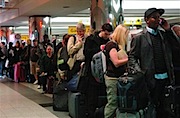
This week the U.S. domestic carriers have been in the throes of the usual first-week-of-the-month traffic and RASM reporting ritual.
And what have we found out from the various press releases full of mind-numbing numbers?
I think Gary Chase, analyst with Barclays started the week off on the right tone as he wrote, “We think the market was largely ready for numbers as bad as CAL posted last night, even if we had hoped for better.”
Continental reported at the beginning of the week that it estimates the H1N1 scare cost the airline at least $30 million in revenue. This was more than many analysts had expected, and was clearly a big factor in the airline reporting that consolidated PRASM for May was down between 19.5% and 20.5%. Mainline only was down between 19% and 20%.
Friday morning Bill Greene, analyst with Morgan Stanley issued a note in which he said, “Recent, May traffic reports highlight the severity of the supply/demand differential plaguing the industry with RASM falling ~20% YoY at both CAL and LCC. Surprisingly, managements continue to bet on a 4Q recovery, as evidenced by the sequential acceleration in capacity growth between 3Q and 4Q09.However, even if a rebound does materialize, we worry that higher oil prices obstruct profit-improvement at many airline.”
Looking towards June, as I wrote in this week’s PBB, I am not hearing much of anything positive from the airline folks I am talking to — in terms of demand uptick.
Kevin Crissey, analyst withUBS wrote this week, “Airline financials are troubling, particularly with fuel prices rising.” He continued, “We are concerned about the revenue outlook after May,” said Crissey, who forecasts that June traffic “will be 2 to 3 percent worse” than May and “July could look like May. The forward curve for fuel is higher.”
Of course, as has been the case over the last year, there is one domestic airline that just keeps bucking the drop in demand trend. That airline is Allegiant Air, the airline portion of Allegiant Travel.
The airline reported Thursday that its total RPMs rose 20.1% while capacity was up 19%. While this resulted in only a 0.8 point increase in load factor for the month, you can pretty much be assured that this is going to be the most positive combo of demand and capacity that will be reported for the month.
Scheduled service at the airline increased 23.9% while capacity jumped 22.9%. Load factor increased 0.7 percentage points to 90.6% from 89.9%.
Both AirTran and Southwest Airlines announced drops in load factor this week.
Remember that these declines also came as both airlines were engaged in pretty stiff fare competition, so we can pretty much figure both airlines posted some healthy declines in yield and RASM as a result.
US Airways, which also reports RASM estimates, as does Continental, reported on Wednesday that its mainline traffic declined 5.2% on a 5.8% cut in capacity. As a result, the airline actually posted a .5 point increase in load factor.
However, as Bill Greene mentioned in his note on Friday, the airline also said that its consolidated PRASM fell between 18% and 20% during the month.
Also note that American Airlines saw traffic fall much more than the airline’s capacity cuts — as the airline reported that mainline traffic declined 11.7% in May, on a capacity decline of only 8.8% This resulted in a 2.6 point drop in load factor for the month. Ouch.
